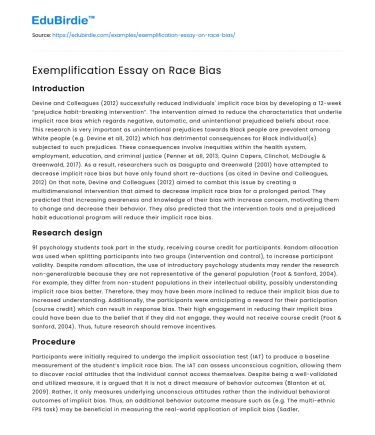Introduction
Devine and Colleagues (2012) successfully reduced individuals' implicit race bias by developing a 12-week “prejudice habit-breaking intervention”. The intervention aimed to reduce the characteristics that underlie implicit race bias which regards negative, automatic, and unintentional prejudiced beliefs about race. This research is very important as unintentional prejudices towards Black people are prevalent among White people (e.g. Devine et all, 2012) which has detrimental consequences for Black individual(s) subjected to such prejudices. These consequences involve inequities within the health system, employment, education, and criminal justice (Penner et all, 2013; Quinn Capers, Clinchot, McDougle & Greenwald, 2017). As a result, researchers such as Dasgupta and Greenwald (2001) have attempted to decrease implicit race bias but have only found short re-ductions (as cited in Devine and Colleagues, 2012) On that note, Devine and Colleagues (2012) aimed to combat this issue by creating a multidimensional intervention that aimed to decrease implicit race bias for a prolonged period. They predicted that increasing awareness and knowledge of their bias with increase concern, motivating them to change and decrease their behavior. They also predicted that the intervention tools and a prejudiced habit educational program will reduce their implicit race bias.
Research design
91 psychology students took part in the study, receiving course credit for participants. Random allocation was used when splitting participants into two groups (intervention and control), to increase participant validity. Despite random allocation, the use of introductory psychology students may render the research non-generalizable because they are not representative of the general population (Foot & Sanford, 2004). For example, they differ from non-student populations in their intellectual ability, possibly understanding implicit race bias better. Therefore, they may have been more inclined to reduce their implicit bias due to increased understanding. Additionally, the participants were anticipating a reward for their participation (course credit) which can result in response bias. Their high engagement in reducing their implicit bias could have been due to the belief that if they did not engage, they would not receive course credit (Foot & Sanford, 2004). Thus, future research should remove incentives.
Save your time!
We can take care of your essay
- Proper editing and formatting
- Free revision, title page, and bibliography
- Flexible prices and money-back guarantee
Procedure
Participants were initially required to undergo the implicit association test (IAT) to produce a baseline measurement of the student’s implicit race bias. The IAT can assess unconscious cognition, allowing them to discover racial attitudes that the individual cannot access themselves. Despite being a well-validated and utilized measure, it is argued that it is not a direct measure of behavior outcomes (Blanton et al, 2009). Rather, it only measures underlying unconscious attitudes rather than the individual behavioral outcomes of implicit bias. Thus, an additional behavior outcome measure such as (e.g. The multi-ethnic FPS task) may be beneficial in measuring the real-world application of implicit bias (Sadler, Correll, Park & Judd, 2012). However, this may not be necessary because research has shown that the IAT is related to behavioral outcomes such as aggression (McConnell & Leibold, 2001). 90% of the participants in the Devine et al (2012) study demonstrated a preference for White people over Black people, according to the IAT. Their scores were then feedback to the participants, making them aware in an attempt to increase concern and motivate them to change.
In addition to implicit bias measurement, explicit bias was also measured using a range of techniques (e.g. measuring racial attitudes). After bringing awareness to the participant's implicit bias, the intervention began. Firstly, they were educated about implicit bias in the form of a 45-minute interactive slide show which aimed to increase understanding of the prejudice habit and implicit bias regarding automaticity, development, how IAT measures implicit bias, and the negative consequences of Implicit race bias.
behavioral change models suggest that individuals who are educated on their behavior are more likely to change their behavior (Michie, Alkins & West, 2014). Therefore, Devine and Colleagues' (2012) method of training their participants was likely to increase the efficacy of their intervention.
Participants were taught a range of techniques to combat their implicit race bias which were intended to be used in their everyday life. Strategies included removing racial stereotypes, counter–stereotypic imaging, perspective taking, individuation, and increasing personal contact. The IAT was then administered at week 4 and at week 8. Devine and Colleagues' intervention was shown to decrease implicit race bias for a prolonged period of time. However, it is uncertain whether all the strategies are beneficial. For example, research that investigated the efficacy of implicit bias interventions found that perspective-taking was not effective in reducing implicit bias (Lai and colleagues, 2014). Interestingly, faking the IAT was highly effective which may cause concern about the overall validity of the IAT that was administered at week 4 and at week 8 in the Devine et al (2012) study. Participants may have faked the IAT to trick the researchers into thinking that their implicit race bias has decreased.
Results:
The main findings found that participants who took part in the intervention experienced a significant reduction in IAT score than participants in the control group, signifying a decrease in implicit race bias. This reduction was maintained over time. Levels of concern predicted levels of implicit bias, demonstrating that increased concern results in a decrease in implicit bias. The explicit measures (racial attitudes) remained the same throughout and thus were not influenced by the intervention.
Previous research demonstrated momentarily decreases in implicit race bias. Thus, Devine and Colleagues (2012) were the first to develop an intervention that caused prolonged effects, setting the foundation for future research. Despite methodological issues, the research was very important in demonstrating how implicit bias can be decreased using an integrated approach. Further research requires using a sample population that is more representative of the general public, removing incentives, incorporating behavioral measures in addition to IAT, and utilizing effective implicit reduction strategies.






 Stuck on your essay?
Stuck on your essay?

